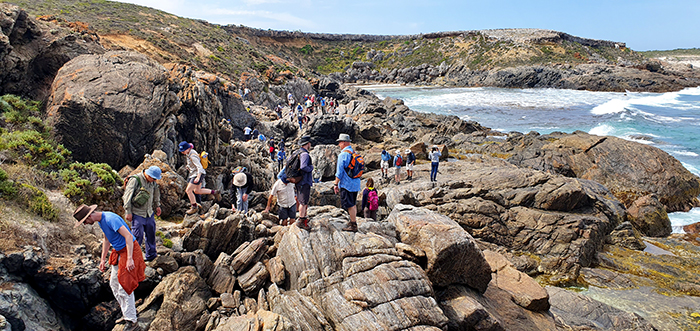Latest developments in structural geology, tectonics and solid earth geophysics.
The spotlight was on the Gawler Craton in late November when more than 120 geoscientists from around the world gathered at Port Lincoln for the Geological Society of Australia’s Convergence on the Coast.
This 2019 biennial meeting of the Specialist Groups in Tectonics and Structural Geology and Solid Earth Geophysics was built around eight interdisciplinary themes and headlined by a superb line-up of keynote speakers from Australia and overseas.
Dr Elena Sizova from the University of Gratz, Austria, presented a number of dynamic numerical models designed to show the change in the evolution of convergent margins from the Archean to Phanerozoic and the metamorphic rocks and tectonic styles expected under these conditions. Professor Gianreto Manatschal from the University of Strasbourg, France, presented an excellent framework for integrating inherited structure into the models of formation and reactivation of both rifted margins and collisional orogens. The Geological Survey of Canada’s Dr Louise Corriveau headlined the mineral systems theme with an amazing description of the sequence of alteration facies observed in iron oxide – copper–gold systems and the change from brittle to ductile behaviour based on the different alteration facies. Harvard University's Dr Mark Hoggard presented new work on long wavelength mantle dynamics controlling dynamic topography and the control that exerts on everything from local sea level to river systems to ocean currents.
From the Australian National University (ANU), Emeritus Professor Stephen Cox modelled fluid flux and volumes in modern seismogenic hydrothermal systems. He used that information to determine the fluid flux and timescales required to develop fault-related hydrothermal ore deposits. Kathryn Hayward headlined the experimental studies theme with her work at ANU to understand the microscale dynamics of fault rupture. Also from the ANU, Associate Professor Meghan Miller presented new seismic imaging data from the western Mediterranean highlighting the interplay of mantle flow induced by the down-going African slab on the tectonics and topography of the Atlas Mountains in northern Africa. Dr Naomi Tucker from the University of Western Australia presented new work linking crustal elements of Antarctica and Australia and the Mesoproterozoic evolution recorded between the Musgrave Province and the Bunger Hills.
A complete list of speakers (including geoscientists from the Geological Survey of South Australia (GSSA)) and the abstract volume is available from the conference website.
With a complex tectonic history spanning from c. 3200 to 1450 Ma, the Gawler Craton presented multiple field trip opportunities. The GSSA led a preconference excursion looking at the geology and mineral systems of the eastern Gawler Craton. A mid-conference field trip took in the stunning exposures of the Kalinjala Shear Zone at Port Neill and high-grade Sleaford Complex gneisses at Fishery Bay.
Examining high-grade Sleaford Complex gneisses at Fishery Bay. (Photo 418051)
The GSSA also played an active role on the organising committee which this year took a proactive approach to diversity and inclusion. Five of the eight keynote speakers were women, and half were early to mid-career researchers. A large contingent of student from universities across Australia gave presentations. The Geological Society of Australia’s student bursary recipients were given the opportunity to chair the sessions, giving them exposure and the confidence to engage with more experienced people at the event.
Awards
An event highlight was the presentation of the Specialist Group in Tectonics and Structural Geology awards at the conference dinner.
The Bruce Hobbs medal for excellent contributions to structural geology was awarded to South Australia’s own Professor Ken McClay, for his outstanding contributions to structural geology over the last 40 years.
The Chris Powell Medal for an outstanding research paper arising from postgraduate research on some aspect of structural geology or tectonics was awarded to Kathryn Hayward from ANU for her paper ‘Mechanical amorphization, flash heating, and frictional melting: dramatic changes to fault surfaces during the first millisecond of earthquake slip’ published in 2016 in Geology 44(12):1043-1046.
– Rian Dutch, December 2019



